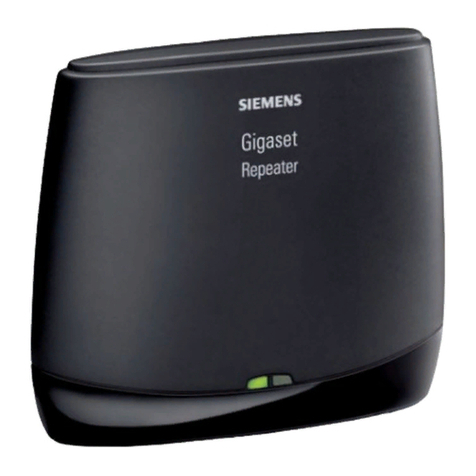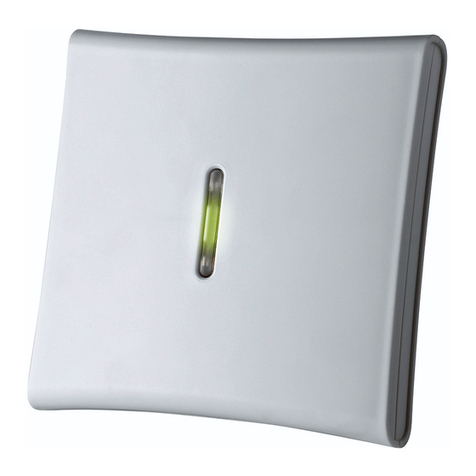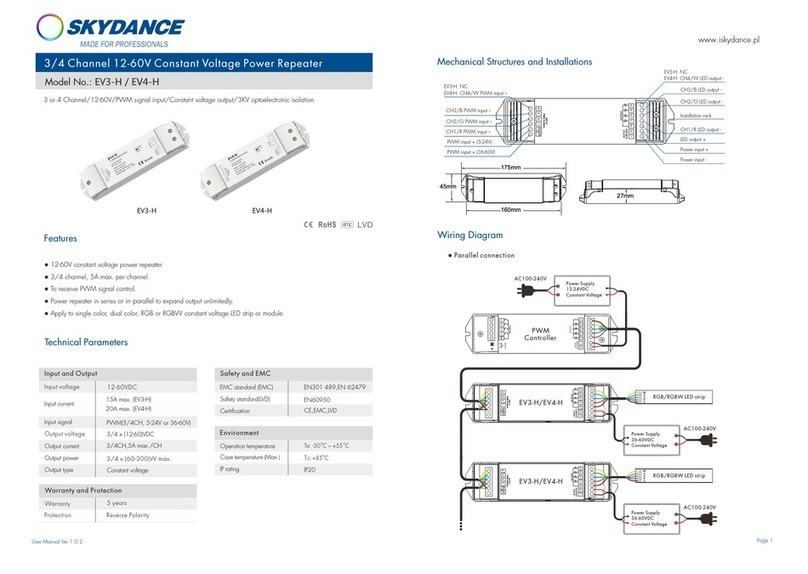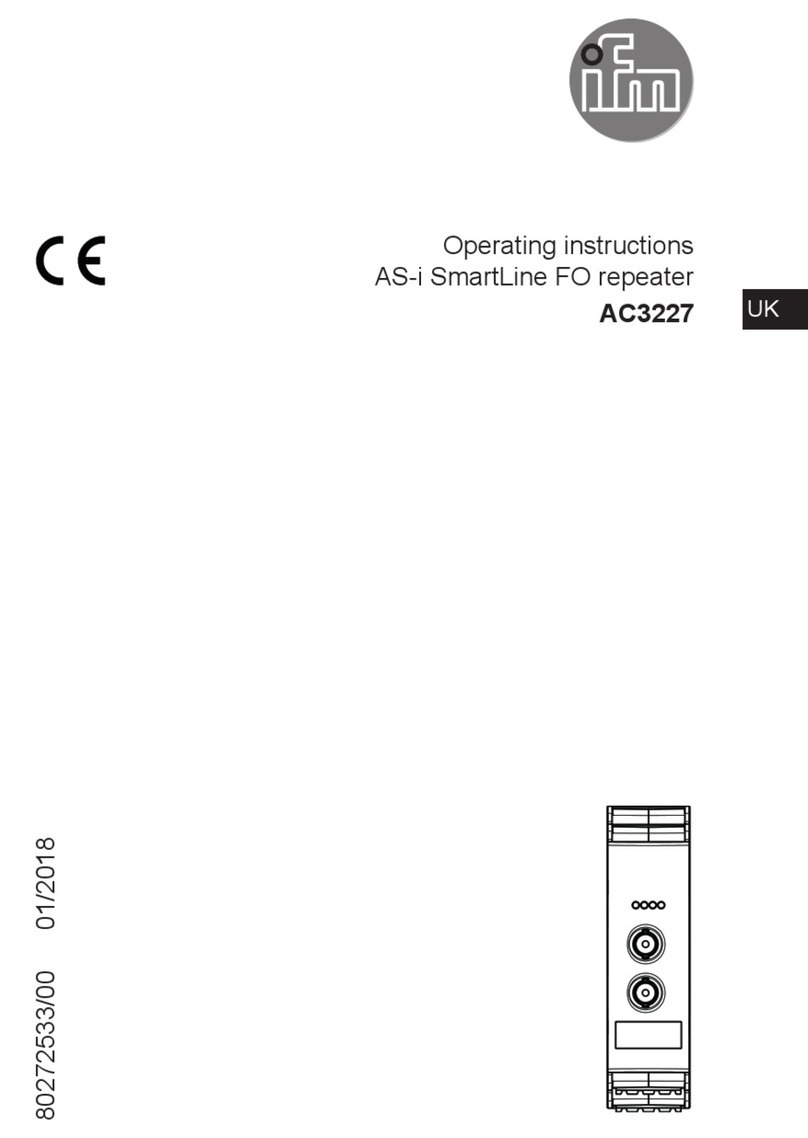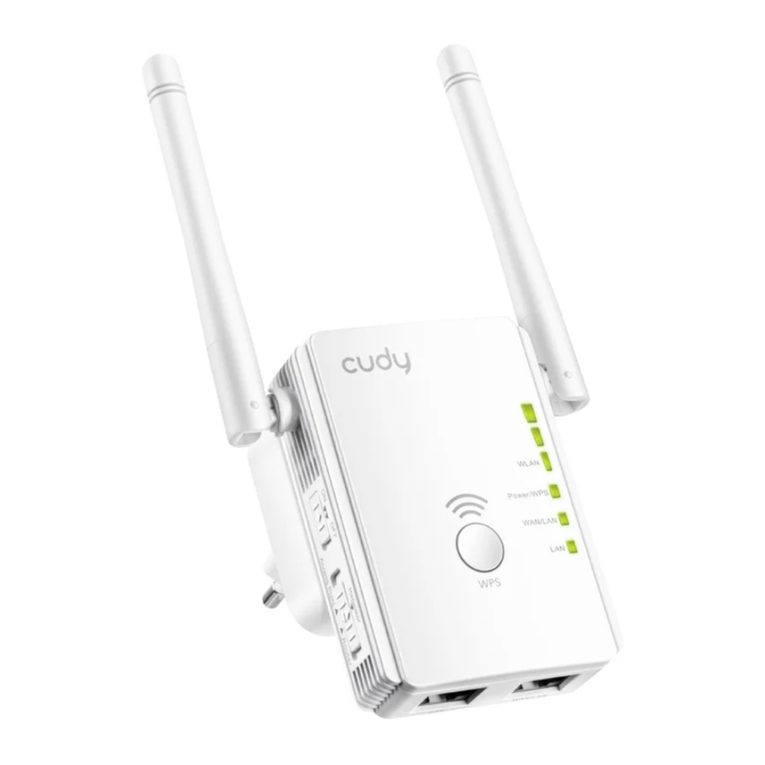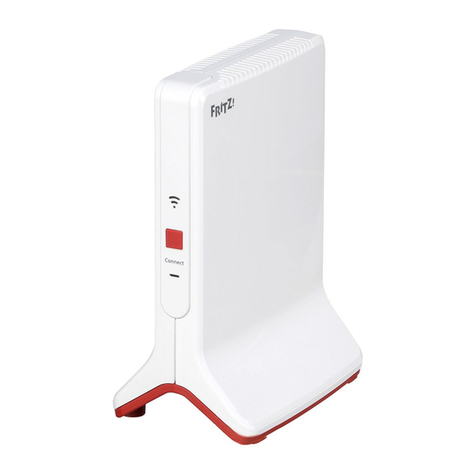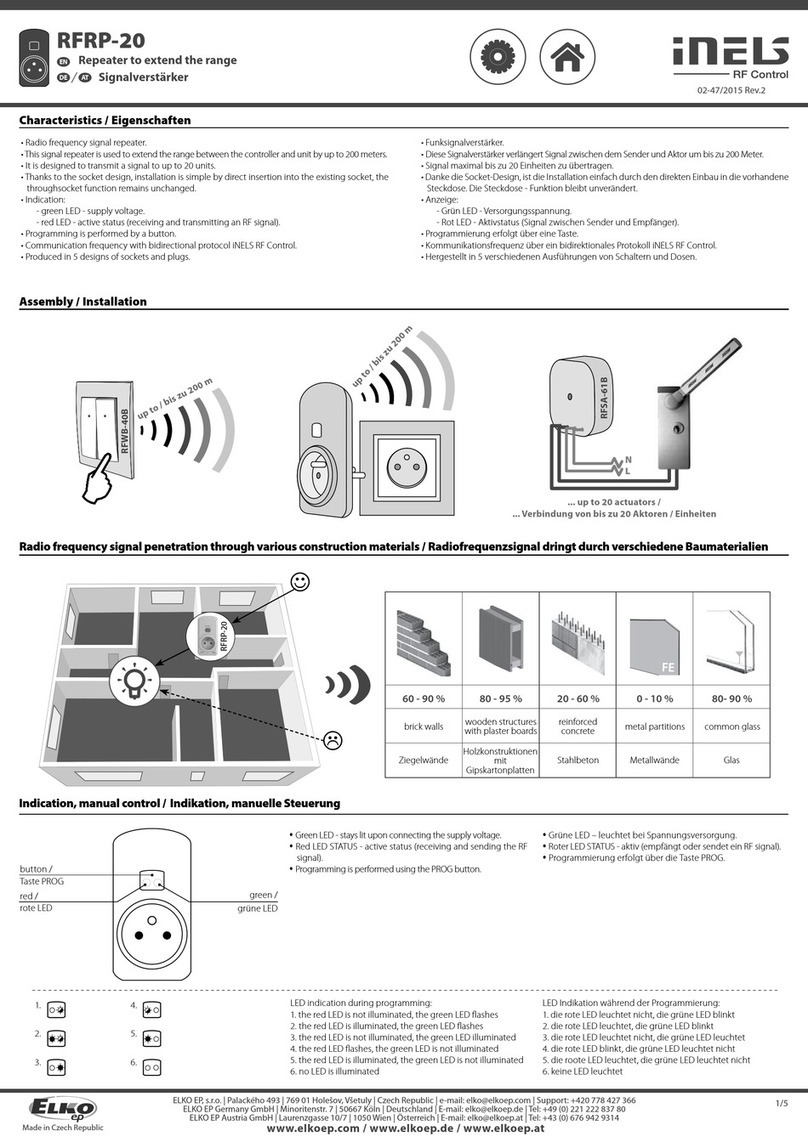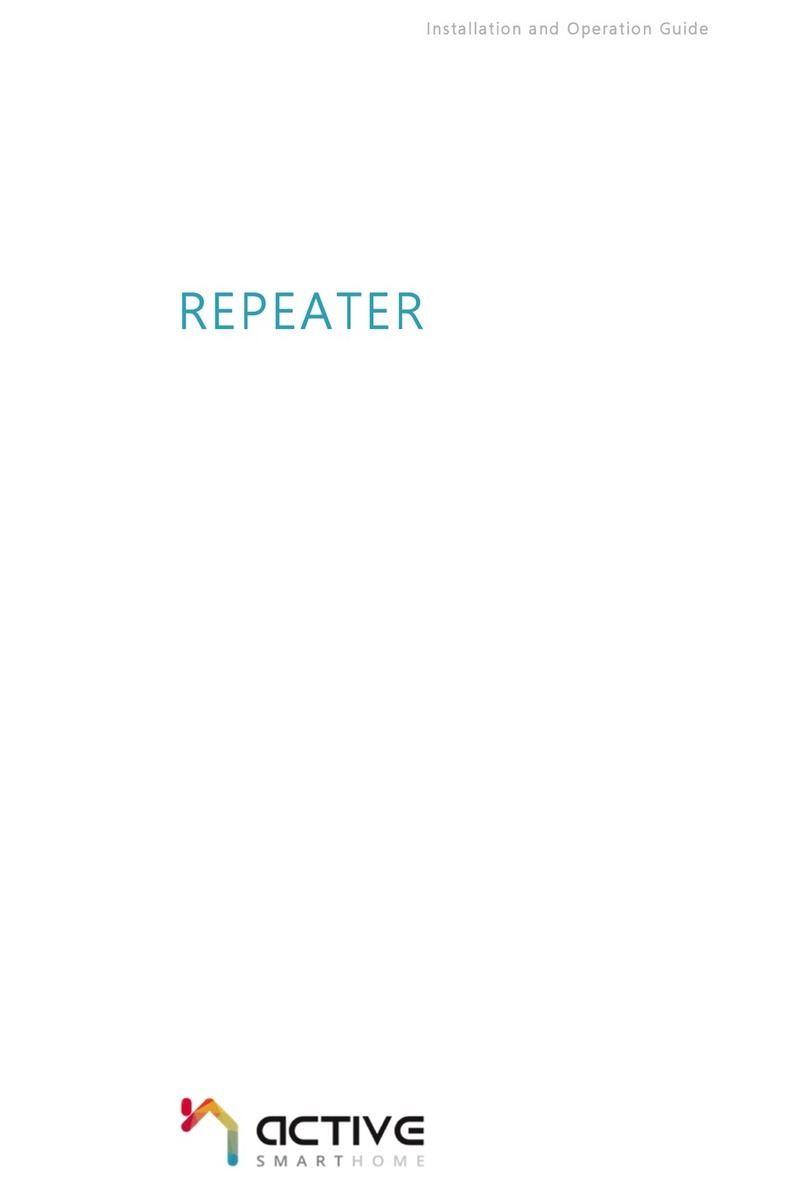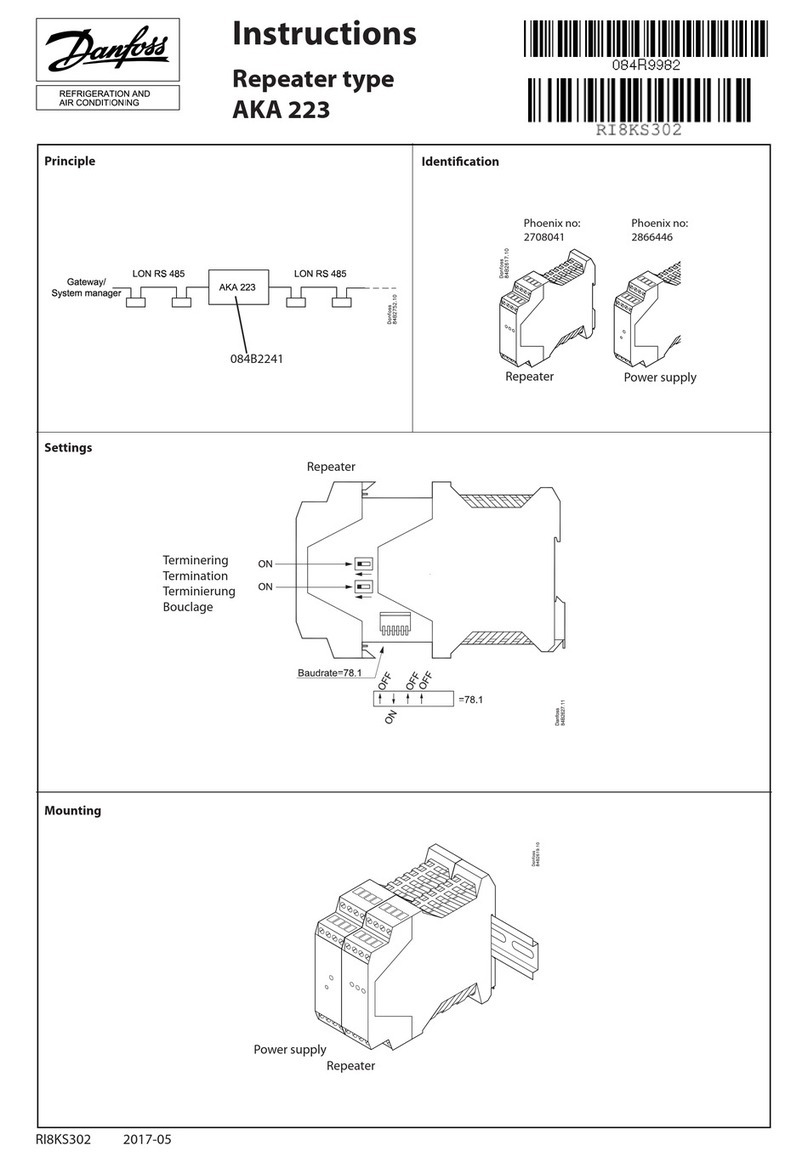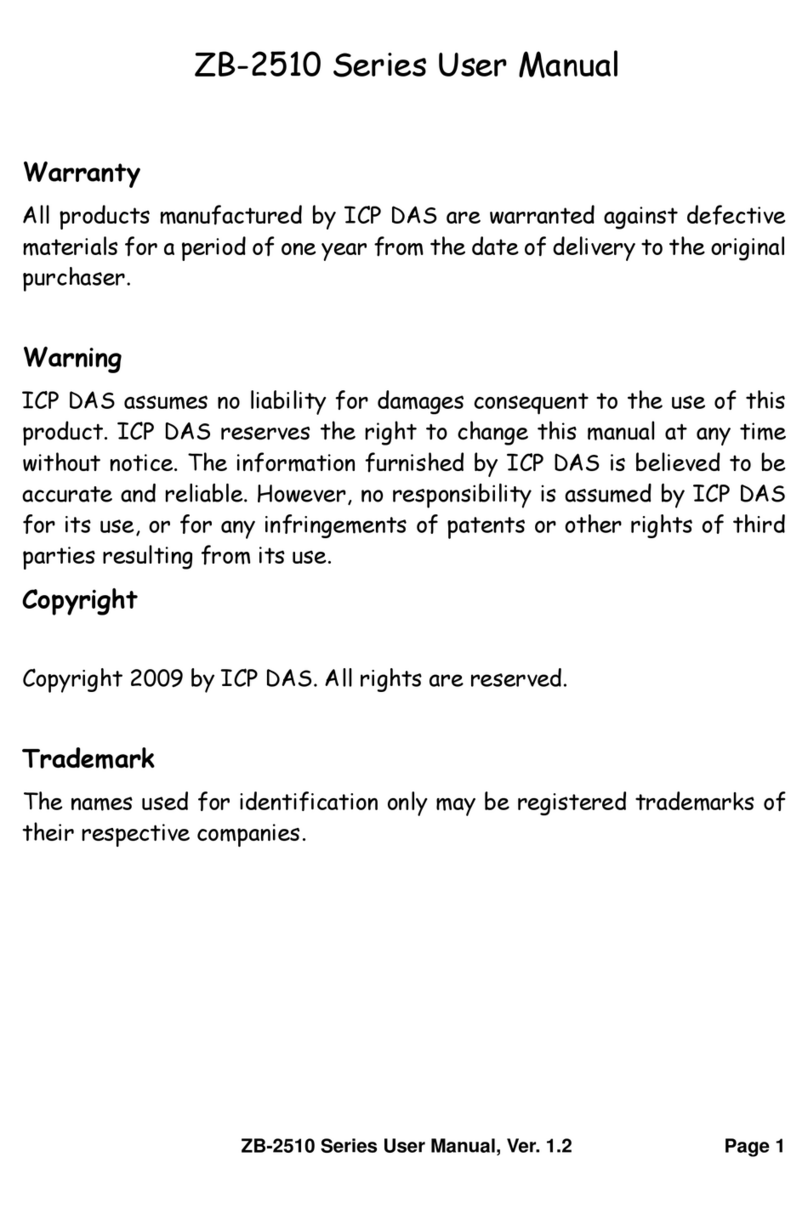Gilderfluke Sd-25 Quick guide

Sd-25 Configuration & Installation
!Before the Sd-25 can be used, you will need to load your SoundFiles onto a MMC/Sd flash card, attach a power
supply, speakers, and (optionally) a switch to start the Sd-25. Selecting the operating mode will tell the Sd-25 how you
would like your SoundFiles to be played.
MMC/Sd Card:
Any 3.3 volt Multi Media Card (MMC) or Secure
Digital (Sd) flash memory card
can be used with the Sd-25.
Starting with version 1.16 of
the Sd-25 firmware, Sd HC
cards are also supported.
These will be available with
capacities up to 2048
GBytes. As of this writing, Sd
cards are available in sizes
up to eight GBytes. These
hold about 2000 typical Mp3
songs for about four days of
continuous audio playback.
The Sd-25 supports up to
255 SoundFiles in most op-
erating modes. Some modes
support up to 32,767 Sound-
Files.
The flash card should be
formatted ʻFATʼor ʻFAT32ʼ(it
will probably come that
way). The order in which
the SoundFiles are placed
onto the card is the order
in which the Sd-25 will
play them. You can load
Mp3 and .wav files onto
the card using a flash card
writer attached to a PC or
Mac.
For the Sd-25s to recog-
nize a SoundFile, its FileName must start with an
alphanumeric character, and it must have the exten-
sion of either ʻ.wavʼor ʻ.Mp3ʼ. If a SoundFile meets
these criteria, the Sd-25 will attempt to play it. If the
Sd-25 canʼt play a SoundFile for any reason, it will
give up after about three seconds.
The Sd-25 will play just about all Mp3 or .wav file
formats. Mp3 bit rates up through 320 Kb/second
are supported. .wav files of up to 48 Kbytes/second
and sixteen bit are supported. If a file does not play,
it is most often caused by a large (more than 2
MBytes) ʻid3ʼtag at its front. These typically
hold the album cover artwork for files down-
loaded from iTunes and similar sources.
Since a Sd-25 canʼt use album artwork, it
simply takes up additional storage space,
delays the time it takes a SoundFile
to start playing, and (in the worst
case), will keep a SoundFile from
playing at all. Most audio programs
(including iTunes) have an option to
delete ʻid3ʼtags.
Speaker Outputs:
The Sd-25ʼsamplifier is a ʻClass-Dʼ
design. Its efficiency is near 90%. If
you feed 50 Watts of 24 vdc into the
Sd-25ʼsamplifier, you will get al-
most 50 Watts into your speakers.
ʻLinearʼamplifiers have only about
20% efficiency. Fully 80% of
the power you put into
them goes into the
heatsink as waste heat. A
50 Watt linear amplifier
would only feed 10 Watts of
power into your speakers,
and 40 Watts into the
heatsink. This makes the
Sd-25ʼsamplifier roughly
equivalent to what would be
a 200 Watt linear amplifier!
If you are going to run your speakers at high SPLs,
you will need to select speakers that can handle at
least a 125 to 150 Watts or more of continuous
power. Speakers smaller than this may clip or be
damaged if run at too high an output power level
from the Sd-25.
The amplifier outputs from the Sd-25 can be used
with speakers of four to eight ohms impedance. As
with any amplifier, you can series/parallel a number
Gilderfluke & Co.• 205 South Flower Street • Burbank, California 91502 • 818/840-9484 • 800/776-5972 • fax 818/840-9485
page 1 of 16 • © February 11, 2014 Gilderfluke & Co. DCM
Audio Repeater
Sd-25
Gilderfluke & Company
Burbank, California
B
Left Right
12–24 vdc
Power
Power
12–24
vdc
A
Running
Status
Level
Sd-
Left
Line InLevel Line In Level Level
Sd-
Right
Trigger
Inputs
Speakers
(4!to 8!)
Mixer
Right
Mixer
Left
Power Supply
12 to 24 vdc
Optional Line
Level Source
Switch 'B'
Switch 'A'

B
A
Running
Status
Inputs
Switch ‘b’
External power for Switches & Status
Battery
Left
Switch ‘a’
Power
9-24 vdc
Right
Speakers
Left
ʻBridgedʼ
Speaker
Connections
Br-MiniBrick4
Gilderfluke & Co.
Burbank, California
0
1
2
3
Record
Go
Data
Trigger
9-24
vdc
Outputs
Outputs
Triggering from a
Control System
A
Inputs
B
Sd-10
of speakers, so long as the impedance remains
within limits.
If your speaker seems to clip out at an unusually low
level, it may be that the speaker protection circuitry
inside the crossover is confused by the digital output
of the Sd-25ʼs amplifier. If this is the case, we have
a small filter module available that can smooth the
signal the speaker receives.
The Sd-25ʼsamplifier is well protected from short
circuits and overheating. You can stick a screwdriver
right across the speaker terminals, and the Sd-25ʻs
amplifier will go back to work an instant after a fault
is removed. If the speaker impedance is too low and
you are running at a high volume level, the amplifier
may start to cut out. If you hear this, check the
power supply voltage. If the input voltage is drop-
ping, you might simply be drawing too much power
for the power supply and a larger supply may fix
your problem. If the power supply is OK, and you
canʼt increase the speaker impedance, then you
might simply be asking too much of the Sd-25ʼs
amplifier, and need to turn down the volume a tad.
If you wish to comply with FCC and CE standards
for radio frequency emissions, you should use
shielded speaker wires with the Sd-25. The shield
should be attached to the power supply ʻnegativeʼ
terminal, which is immediately adjacent to the
speaker terminals. This will not affect the sound
quality from the Sd-25, but will make the FCC and
CE folks happy. Shielded speaker lines were used
during all CE/FCC certification testing.
Bridged Amplifier: If you need a mono output with
more ʻoomphʼ, the amplifier in the Sd-25 can be
ʻbridgedʼ. Bridging will only have an effect with lower
impedance speakers You wonʼt hear a bit of differ-
ence if you are using an 8 ohm speaker. The only
audio which is amplified comes from the ʻleftʼ
sources (mixer and repeater). The wiring to ʻbridgeʼ
the amplifier is a little different than on a
linear amplifier. The speaker is wired in
parallel to both speaker outputs, and the
jumper inside the Sd-25 is moved to the
ʻbridgedʼposition. Wiring the speak-
ers for a ʻbridgedʼoutput without
moving this jumper can damage the
Sd-25ʼs amplifier.
Trigger Inputs:
The trigger inputs can be used with any
switch. This can be a pushbutton, motion
detector, IR beam, step mat, a digital sig-
nal from a control system, or anything
else that will give you a ʻpowered switch
closureʼ. The trigger inputs are non-
polarized (they donʼt care which terminal
is positive or negative) and opto-isolated.
You must feed a DC voltage into them.
Just touching a pair of leads from a nine
volt transistor radio battery is a good test
of the inputs. As shown at the middle of
the last page, you can ʻborrowʼsome of
the power that is running the Sd-25 using
the adjacent screw terminals, or use a
separate isolated supply (as shown at
left). The power supply is shown as a bat-
tery, but can be any power supply from 9
to 24 vdc.
Not surprisingly, all Gilderfluke & Co. control sys-
tems are easy to attach to a Sd-25. A Br-
miniBrick4 is shown, but all of our systems are
wired in exactly the same way. The common posi-
tive is run to one side of both Sd-25 inputs, and the
control system outputs are wired right to the Sd-25
inputs.
The ʻInputʼLEDs that are next to
the two Sd-25 inputs will light when
each input is active.
Power Supply:
The Sd-25 will run on any
voltage from 12 through
24 vdc. Whatever voltage
you use will also be used
to run the amplifier. If you
arenʼt using the amplifier,
the Sd-25 will run on less than 50 ma. Size your
power supply so it will provide enough current for
the volume you are planning to run at. The amplifier
will put out more power at 24 volts than it can at a
lower voltage. If using all 50 Watts of the amplifier
power, you will need to use a 24 volt supply rated at
least 60 Watts. If you hear clipping, the speakers or
power supply may be undersized for your applica-
tion.
The power supply can be attached through the 2.1
mm power jack, or the screw terminals. Power Sup-
ply voltages higher than 24 vdc can damage the
amplifier on the Sd-25.
Gilderfluke & Co.• 205 South Flower Street • Burbank, California 91502 • 818/840-9484 • 800/776-5972 • fax 818/840-9485
page 2 of 16 • © February 11, 2014 Gilderfluke & Co. DCM
Sd-25

Volume Controls:
A pair of small trimpots on the Sd-25 are used to set
the maximum audio output level from the MMC/Sd
card. The operating modes which ramp the audio up
and down can never exceed the level set by these
pots.
An additional pair of pots is used to set the levels for
the ʻmixerʼinputs.
With the case top on or off, you can adjust these
pots using a small ʻtrimmerʼscrewdriver.
These trimpots are smaller than you. Do not use a
big screwdriver on them. Do not apply too much
force. They will break!
Mixer Inputs:
Two line level ʻmixerʼinputs are available on version
1.6 and later Sd-25s. A line level audio signal from a
Sd-10 audio repeater, pre-amplified microphone or
any other line-level audio source can be plugged
into these two RCA jacks. Two trimpots can be used
to adjust the levels of the mixer inputs.
In this example, a preamplified microphone is fed
into the mixer inputs of the Sd-25. The ʻPush to Talkʼ
button on the microphone is fed into the ʻbʼinput of
the Sd-25. The Sd-25 is configured to ʻduckʼthe
audio from MMC/Sd card to a lower level when it
sees a closure on the ʻbʼinput. When the micro-
phone button is pressed, the Sd-25 ramps the pre-
recorded audio down to a lower level, and the mi-
crophone is used to make an announcement. When
the button is released, the prerecorded audio ramps
back up to the normal playback level.
Sd-25s earlier than hardware version 1.5 features
line level outputs instead of mixer inputs. If you need
line level outputs, these are available as a no-cost
factory option when you order a new Sd-25. To use
the line level outputs, just run a pair of RCA cables
to your amplifier (or amplified speakers), just as you
would if you were connecting a CD player. The line
level outputs are robust enough to drive head-
phones and small speakers directly.
Modulation LEDs:
The two ʻmodulationʼLEDs, which are located in
front of the speaker screw terminals, blink to show
audio being reproduced. They pick up the audio sig-
nal coming from the repeater before the two volume
control pots, so they are not affected by adjusting
these pots or by the auxiliary ʻmixer inputs. Reduc-
ing the audio level through one of the ʻrampingʼ
functions will reduce the intensity of these LEDs.
Audio at too low a level will cause these LEDs to
completely extinguish. Normalize your audio before
loading it on the Sd-25 so that it is near 100%
modulation.
Sometimes additional safety system assurance
above and beyond monitoring the ʻStatusʼoutput is
needed to confirm that the Sd-25 is actually playing.
An external solid state relay or optoisolator can be
attached in place of these LEDs. The safety system
can then monitor this to confirm that an audio signal
is indeed being generated. Contact Gilderfluke &
Company for more information on this sort of appli-
cation.
Status Output:
A single uncommitted optoisolator output is available
for remote monitoring of the Sd-25. It is ʻonʼonly
while the Sd-25 is playing a triggered or ʻforegroundʼ
SoundFile. It can be used to control ducking mixers,
relays, or whatever you need.
To turn on a light, motor, or other electrical device
while a triggered or foreground SoundFile is playing,
just wire a solid state relay to the status output.
Then wire the light, motor, or whatever you are con-
trolling to this relay. This can be used in a museum,
trade show, Point Of Sale (POS) and other applica-
tions.
In applications where a background audio SoundFile
that doesnʼt stop when a foreground SoundFile is
playing, the BGM SoundFile can be played from a
Sd-10 which feeds its audio into the ʻmixerʼinputs of
the Sd-25.
Gilderfluke & Co.• 205 South Flower Street • Burbank, California 91502 • 818/840-9484 • 800/776-5972 • fax 818/840-9485
page 3 of 16 • © February 11, 2014 Gilderfluke & Co. DCM

When the Sd-25 plays a triggered SoundFile or a
timed announcement (using modes 16, 17 or Store-
Caster mode) the status output will go active. This is
wired into an input on the Sd-10 which has been
configured to duck, or fully mute its audio output. In
this way, the Sd-10 will duck (or mute) the BGM
SoundFile (without stopping it) while the foreground
SoundFile plays.
ʻBackgroundʼlooping SoundFiles, like those in
modes 16 and 17 will not turn on the ʻStatusʼoutput.
When in these modes, the ʻStatusʼoutput will only
be turned on when a triggered SoundFile is playing.
In StoreCaster mode, the ʻStatusʼoutput will only be
turned on when playing SoundFile #1.
In a safety related application, such as a fire or
emergency annunciator system, the safety system
can monitor this output to confirm the Sd-25 is re-
ceiving commands and playing SoundFiles. For ab-
solute surety, you can monitor that this output goes
active when a SoundFile is triggered, and goes inac-
tive at the end of the SoundFile.
Status Output LED:
The LED which is next to the ʻStatusʼoutput does
not reflect the current state of that output. Instead, it
flashes to show accesses to the MMC/Sd flash card
by the Sd-25.
This LED will flicker when a Sd-25 boots, as it
counts each SoundFile on the card1. When not play-
ing, it will be very dim. While playing, it will flicker at
a high rate of speed. The faster the flicker, the
higher your SoundFileʼs bit rate.
Gilderfluke & Co.• 205 South Flower Street • Burbank, California 91502 • 818/840-9484 • 800/776-5972 • fax 818/840-9485
page 4 of 16 • © February 11, 2014 Gilderfluke & Co. DCM
1The speed at which the Sd-25 counts the SoundFiles is perhaps the best indication of how ‘fast’ a SD flash card is. Fast cards will count up to ten SoundFiles
each second. Slower cards may only count one SoundFile per second.

Sd-25 Configuration
!The Sd-25 is configured using a ten position DipSwitch. The cover of the Sd-25 must be snapped off to
reach this DipSwitch. A ball point pen or any other pointy object can be used to flip the switches once the cover
has been removed. Do not use a knife or other sharp object, as it might damage the switch.
Mode Name
Mode
#
Trig-
gers
Input ʻAʼ
Input ʻBʼ
DipSwitches
1 thru 5
Options
Looping SoundFiles with Mutes
0
0
Ramps to Muted
Ramps to -3dB
off/off/off/off/off
1,8,10
1
Ramps to -6dB
on/off/off/off/off
1,8,10
2
Ramps to -9dB
off/on/off/off/off
1,8,10
3
Ramps to -12dB
on/on/off/off/off
1,8,10
4
Ramps to -18dB
off//off/on/off/off
1,8,10
5
Ramps to -24dB
on/off/on/off/off
1,8,10
6
Ramps to -33dB
off/on/on/off/off
1,8,10
7
Ramps to -48dB
on/on/on/off/off
1,8,10
Fast access to 1st SoundFile
8
2
Play 1st SoundFile only
Play All SoundFiles
off/off/off/on/off
2,6,7,8,9,10
Exclusive access to 1st SoundFile
9
2
Play 2nd thru Last
on/off/off/on/off
2,6,7,8,9,10
Two Triggers and One Reshuffle
A
2
Reshuffle & Play 1st SoundFile
Play All SoundFiles
off/on/off/on/off
2,6,7,8,9,10
Two Triggers with Exclusive access to 1st
SoundFile/Reshuffle
B
2
Play 2nd thru Last
on/on/off/on/off
2,6,7,8,9,10
Single trigger with Reshuffle
C
1
Play All SoundFiles
Reshuffle
off/off/on/on/off
2,6,7,8,9,10
Single trigger with Mute
d
1
Play All SoundFiles
Ramps to -6dB
on/off/on/on/off
1, 8, 9, 10
E
Ramps to -12dB
off/on/on/on/off
1, 8, 9, 10
F
Ramps to -24dB
on/on/on/on/off
1, 8, 9, 10
10
Ramps to Muted
off/off/off/off/on
1, 8, 9, 10
Single trigger, Mute or Reshuffle
Short Pulses on ‘B’ Reshuffle SoundFiles, Long
pulses on ‘B’ ramp audio levels.
11
1
Play All SoundFiles
Short = Reshuffle
Long = Ramps to -6dB
on/off/off/off/on
1, 8, 9, 10
12
Short = Reshuffle
Long = Ramps to -12dB
off/on/off/off/on
1, 8, 9, 10
13
Short = Reshuffle
Long = Ramps to -24dB
on/on/off/off/on
1, 8, 9, 10
14
Short = Reshuffle
Long = Ramps to Mute
off/off/on/off/on
1, 8, 9, 10
Two Playlists
15
2
Play 1st Half SoundFiles
Play 2nd Half SoundFiles
on/off/on/off/on
2,6,7,8,9,10
Two Playlists, First SoundFile Loops between
Triggered SoundFiles
16
2
1st Half SoundFiles
(except First SoundFile)
off/on/on/off/on
2,6,7,8,9,10
Two Playlists, Last SoundFile Loops between
Triggered SoundFiles
17
2
Play 1st Half SoundFiles
2nd Half SoundFiles
(except Last SoundFIle)
on/on/on/off/on
2,6,7,8,9,10
Two Triggers, SoundFiles 3 thru Last Loop be-
tween Triggered SoundsFiles
18
2
Plays 1st SoundFile
Plays 2nd SoundFile
off/off/off/on/on
2,6,7,8,9,10
Store Caster/Safety Messages/Music On Hold
19
0
Mutes All Audio
Ramps to -24dB
on/off/off/on/on
1, 8, 10
IR Normal Mode
1A
0
off/on/off/on/on
1, 8, 9, 10
IR Odd Mode
1B
0
on/on/off/on/on
1, 8, 9, 10
Doug’s Doorbell Mode (v1.16+ only)
1C
1
Plays All SoundFiles
Reshuffle
off/off/on/on/on
2,6,7,8,10
Two Playlists, Last SoundFile Loops between
Triggered SoundFiles
1d
2
Short = Reshuffle
Long = Fade Out then Play 1st
Half of all SoundFiles
Both A & B = Fade Out to level
set by Option #3
Short = Reshuffle
Long = Fade Out then Play 2nd
Half of all SoundFiles
(except Last SoundFIle)
Both A & B = Fade Out to level
set by Option #3
on/off/on/on/on
3, 8, 9, 10
Two Triggers, SoundFiles 3 thru Last Loop be-
tween Triggered SoundsFiles
1E
2
Short = Reshuffle
Long = Fade Out then Plays 1st
SoundFile
Both A & B = Fade Out to level
set by Option #3
Short = Reshuffle
Long = Fade Out then Plays 2nd
SoundFile
Both A & B = Fade Out to level
set by Option #3
off/on/on/on/on
3, 8, 9, 10
Reserved
1F
tbd
tbd
tbd
on/on/on/on/on
tbd
Gilderfluke & Co.• 205 South Flower Street • Burbank, California 91502 • 818/840-9484 • 800/776-5972 • fax 818/840-9485
page 5 of 16 • © February 11, 2014 Gilderfluke & Co. DCM

Options:
Option
Number
Option Name
What it Does
Switches Used to Select Options
Option #1
Audio Ramping Speeds
Immediate Ramping Speed
DipSw. #6 = Off
DipSw. #7 = Off
Fast Ramping Speed
DipSw. #6 = On
DipSw. #7 = Off
Medium Ramping Speed
DipSw. #6 = Off
DipSw. #7 = On
Slow Ramping Speed
DipSw. #6 = On
DipSw. #7 = On
Option #3
(Modes 1d and
1E only)
Audio Mute Levels (Fades
background SoundFiles(s) to
this level before starting fore-
ground SoundFiles)
Ramps to Muted
DipSw. #6 = Off
DipSw. #7 = Off
Ramps to -33dB
DipSw. #6 = On
DipSw. #7 = Off
Ramps to -18dB
DipSw. #6 = Off
DipSw. #7 = On
Ramps to -9dB
DipSw. #6 = On
DipSw. #7 = On
Option #2
Loop selected SoundFiles on sustained inputs
DipSw. #6 = Off
DipSw. #7 = Off
Option #6
SoundFiles do not Loop on sustained inputs (v1.16+ only)
DipSw. #6 = On
DipSw. #7 = Off or On
Option #7
Loop ALL selected SoundFiles on sustained inputs (v1.16+)
DipSw. #6 = Off
DipSw. #7 = On
Option #8
DipSw. #8 = Off: SoundFiles played sequentially
DipSw. #8 = On: Selected SoundFiles played randomly
Option #9
DipSw. #9 = Off: Triggered SoundFiles steppable
DipSw. #9 = On: Triggered SoundFiles Unsteppable
Option #10
DipSw. #10 = Off: Amplifier enabled only while playing
DipSw. #10 = On: Amplifier always Enabled
Operating Modes:
The first five DipSwitches are used to set the mode
of operation for the Sd-25. The remaining five
DipSwitches set the ʻoptionsʼ. The ʻonʼ/ʼoffʼafter
each ʻmodeʼshows which of the first five
DipSwitches need to be turned ʻonʼor ʻoffʼto select
that mode. As an example; to select ʻmode Bʼ, you
would turn ʻonʼswitches one, two and four. Switches
three and five would be turned ʻoffʼ.
Sometimes when the operating mode is switched,
you may need to cycle power to the Sd-25 to assure
it operates as expected.
If you need your SoundFiles(s) to just loop:
use mode 0.
DipSwitches one though five = off/off/off/off/off
If you need to trigger one or more Sound-
Files(s): use mode C.
DipSwitches one though five = off/off/on/on/off
Mode 0 / off/off/off/off/off
Loops with Mutes. Fade to -3dB on ʻbʼ
Mode 1 / on/off/off/off/off
Loops with Mutes. Fade to -6dB on ʻbʼ
Mode 2 / off/on/off/off/off
Loops with Mutes. Fade to -9dB on ʻbʼ
Mode 3 / on/on/off/off/off
Loops with Mutes. Fade to -12dB on ʻbʼ
Mode 4 / off/off/on/off/off
Loops with Mutes. Fade to -18dB on ʻbʼ
Mode 5 / on/off/on/off/off
Loops with Mutes. Fade to -24dB on ʻbʼ
Mode 6 / off/on/on/off/off
Loops with Mutes. Fade to -33dB on ʻbʼ
Mode 7 / on/on/on/off/off
Loops with Mutes. Fade to -48dB on ʻbʼ
Loop all the SoundFiles on the Sd-25, starting at
PowerUp. Input ʻaʼwill ramp the audio to a fully
muted level when activated. The ʻbʼinput ramps the
audio to a ʻhalf mutedʼ(lower) volume. The only dif-
ference among these eight modes is the ʻmutedʼ
volume level the ʻbʼinput selects. These modes will
support up to 32,767 SoundFiles.
Options:
Option #1: DipSwitches #6 and #7 are used to se-
Gilderfluke & Co.• 205 South Flower Street • Burbank, California 91502 • 818/840-9484 • 800/776-5972 • fax 818/840-9485
page 6 of 16 • © February 11, 2014 Gilderfluke & Co. DCM

lect the speed at which the audio ramps in/out.
Option #8: DipSwitch #8: Randomizer. When on,
SoundFiles are played in random order, rather than
sequentially. If less than 255 SoundFiles are loaded
on the Sd-25, then the randomizer checks off each
SoundFile as it is played. It will not play the same
SoundFile a second time until it has played all the
other SoundFile files. If more than 255 SoundFiles
are loaded on to the Sd-25, then the SoundFiles are
played randomly. It does not check to see whether
the same SoundFile has been played recently.
Mode 8 / off/off/off/on/off
Two triggers, with fast access to first SoundFile
Input ʻaʼplays the first SoundFile ONLY, Input ʻbʼ
plays ALL of the SoundFiles on the Sd-25 (Sound-
Files 1 through ??). This mode is used when you
want to use the ʻbʼinput to trigger all of the Sound-
Files, but occasionally want to play the first Sound-
File an extra time.
Options:
Option #2: The one SoundFile that is selected will
loop as long as the input stays active (only on Firm-
ware version 1.16 or later): unless DipSwitch #6 or
DipSwitch #7 are on.
Option #6: DipSwitch #6: (Firmware version 1.16
or later) When on, the SoundFile will only play once
(no looping).
Option #7: DipSwitch #7: (Firmware version 1.16
or later) When on, input ʻaʼwill loop SoundFile #1 as
long as the input stays active, and input ʻbʼwill loop
through ALL of the SoundFiles on the Sd-25
(SoundFiles 1 through ??) as long as the input stays
active.
Option #8: DipSwitch #8: Randomizer. When on,
SoundFiles are played in random order, rather than
sequentially.
Option #9: DipSwitch #9: Unsteppable. When on,
additional start commands to the Sd-25 will be ig-
nored until the currently playing triggered SoundFile
has completed.
Mode 9 / on/off/off/on/off
Two triggers, with fast and exclusive access to first
SoundFile
Like Mode 8, except the B input plays SoundFiles 2
through ?? instead of ʻAllʼthe SoundFiles. This
mode is used when you need a method of triggering
an emergency or other ʻspecialʼannouncement.
Options:
Option #2: The one SoundFile that is selected will
loop as long as the input stays active (only on Firm-
ware version 1.16 or later): unless DipSwitch #6 or
DipSwitch #7 are on.
Option #6: DipSwitch #6: (Firmware version 1.16
or later) When on, the SoundFile will only play once
(no looping).
Option #7: DipSwitch #7: (Firmware version 1.16
or later) When on, input ʻaʼwill loop SoundFile #1 as
long as the input stays active, and input ʻbʼwill loop
through SoundFiles 2 through ?? as long as the in-
put stays active.
Option #8: DipSwitch #8: Randomizer. When on,
SoundFiles are played in random order, rather than
sequentially.
Option #9: DipSwitch #9: Unsteppable. When on,
additional start commands to the Sd-25 will be ig-
nored until the currently playing triggered SoundFile
has completed.
Mode A / off/on/off/on/off
Trigger+reshuffle and a second trigger
Similar to Mode 8, except that input ʻaʼplays the first
SoundFile ONLY and also ʻreshufflesʼthe ʻPlayListʼ
triggered by the ʻbʼinput. Input ʻbʼplays ALL of the
SoundFiles on the Sd-25 (SoundFiles 1 through ??).
Options:
Option #2: The one SoundFile that is selected will
loop as long as the input stays active (only on Firm-
ware version 1.16 or later): unless DipSwitch #6 or
DipSwitch #7 are on.
Option #6: DipSwitch #6: (Firmware version 1.16
or later) When on, the SoundFile will only play once
(no looping).
Option #7: DipSwitch #7: (Firmware version 1.16
or later) When on, input ʻaʼwill loop SoundFile #1 as
long as the input stays active, and input ʻbʼwill loop
through ALL of the SoundFiles on the Sd-25
Gilderfluke & Co.• 205 South Flower Street • Burbank, California 91502 • 818/840-9484 • 800/776-5972 • fax 818/840-9485
page 7 of 16 • © February 11, 2014 Gilderfluke & Co. DCM

(SoundFiles 1 through ??) as long as the input stays
active.
Option #8: DipSwitch #8: Randomizer. When on,
SoundFiles are played in random order, rather than
sequentially.
Option #9: DipSwitch #9: Unsteppable. When on,
additional start commands to the Sd-25 will be ig-
nored until the currently playing triggered SoundFile
has completed.
Mode B / on/on/off/on/off
Like Mode A, except the ʻbʼinput plays SoundFiles 2
through ?? instead of ʻAllʼthe SoundFiles.
Options:
Option #2: The one SoundFile that is selected will
loop as long as the input stays active (only on Firm-
ware version 1.16 or later): unless DipSwitch #6 or
DipSwitch #7 are on.
Option #6: DipSwitch #6: (Firmware version 1.16
or later) When on, the SoundFile will only play once
(no looping).
Option #7: DipSwitch #7: (Firmware version 1.16
or later) When on, input ʻaʼwill loop SoundFile #1 as
long as the input stays active, and input ʻbʼwill loop
through SoundFiles 2 through ?? as long as the in-
put stays active.
Option #8: DipSwitch #8: Randomizer. When on,
SoundFiles are played in random order, rather than
sequentially.
Option #9: DipSwitch #9: Unsteppable. When on,
additional start commands to the Sd-25 will be ig-
nored until the currently playing triggered SoundFile
has completed.
Mode C / off/off/on/on/off
Single trigger with reshuffle
Input ʻaʼplays ALL of the SoundFiles on the Sd-25
(SoundFiles 1 through ??). Input ʻbʼreshuffles the
ʻPlayListʼtriggered by the ʻaʼinput.
Options:
Option #2: The one SoundFile that is selected will
loop as long as the input stays active (only on Firm-
ware version 1.16 or later): unless DipSwitch #6 or
DipSwitch #7 are on.
Option #6: DipSwitch #6: (Firmware version 1.16
or later) When on, the SoundFile will only play once
(no looping).
Option #7: DipSwitch #7: (Firmware version 1.16
or later) When on, input ʻaʼwill loop through Sound-
Files 1 through ?? as long as the input stays active.
Option #8: DipSwitch #8: Randomizer. When on,
SoundFiles are played in random order, rather than
sequentially.
Option #9: DipSwitch #9: Unsteppable. When on,
additional start commands to the Sd-25 will be ig-
nored until the currently playing triggered SoundFile
has completed.
Mode D / on/off/on/on/off
Single trigger with mute on ʻaʼ
Fade to -6dB on ʻbʼ
Mode E / off/on/on/on/off
Single trigger with mute on ʻaʼ
Fade to -12dB on ʻbʼ
Mode F / on/on/on/on/off
Single trigger with mute on ʻaʼ
Fade to -24dB on ʻbʼ
Mode 10 / off/off/off/off/on
Single trigger with mute on ʻaʼ
Fade to muted on ʻbʼ
Input ʻaʼplays ALL of the SoundFiles on the Sd-25
(SoundFiles 1 through ??) on each successive but-
ton press. Firmware versions before v1.27 will loop
a single SoundFile on sustained ʻaʼinput closures.
Firmware versions after v1.27 will loop through ALL
the SoundFiles on the Sd card on sustained ʻaʼinput
closures.
Input ʻbʼramps the audio down -6dB from full vol-
ume. The only difference among the next three
modes is the ʻmutedʼvolume level the ʻbʼinput se-
lects.
Options:
Option #1: DipSwitches #6 and #7 are used to se-
lect the speed at which the audio ramps in/out.
Option #8: DipSwitch #8: Randomizer. When on,
SoundFiles are played in random order, rather than
sequentially.
Gilderfluke & Co.• 205 South Flower Street • Burbank, California 91502 • 818/840-9484 • 800/776-5972 • fax 818/840-9485
page 8 of 16 • © February 11, 2014 Gilderfluke & Co. DCM

Option #9: DipSwitch #9: Unsteppable. When on,
additional start commands to the Sd-25 will be ig-
nored until the currently playing triggered SoundFile
has completed.
Mode 11 / on/off/off/off/on
Single trigger with mute/reshuffle on ʻaʼ
Fade to -6dB on ʻbʼ
Mode 12 / off/on/off/off/on
Single trigger with mute/reshuffle on ʻaʼ
Fade to -12dB on ʻbʼ
Mode 13 / on/on/off/off/on
Single trigger with mute/reshuffle on ʻaʼ
Fade to -24dB on ʻbʼ
Mode 14 / off/off/on/off/on
Single trigger with mute/reshuffle on ʻaʼ
Fade to muted on ʻbʼ
Input ʻaʼplays ALL of the SoundFiles on the Sd-25
(SoundFiles 1 through ??) on each successive but-
ton press. Firmware versions before v1.27 will loop
a single SoundFile on sustained ʻaʼinput closures.
Firmware versions after v1.27 will loop through ALL
the SoundFiles on the Sd card on sustained ʻaʼinput
closures.
A ʻshortʼpulse (more than 1/8 second, but less than
1/4 second) on input ʻbʼʻreshufflesʼthe ʻPlayListʼ
triggered by the ʻaʼinput. A longer closure on input
ʻbʼramps the audio down -6dB from full volume
when activated. The only difference among the next
three modes is the ʻmutedʼvolume level the ʻbʼinput
selects.
Options:
Option #1: DipSwitches #6 and #7 are used to se-
lect the speed at which the audio ramps in/out.
Option #8: DipSwitch #8: Randomizer. When on,
SoundFiles are played in random order, rather than
sequentially.
Option #9: DipSwitch #9: Unsteppable. When on,
additional start commands to the Sd-25 will be ig-
nored until the currently playing triggered SoundFile
has completed.
(Firmware version 1.17 or later) When set to any of
these four modes, SoundFile requests made
through the serial port will be stored up to ten deep,
if you try to start any SoundFile while an unsteppa-
ble SoundFile file is already playing.
Mode 15 / on/off/on/off/on
Two PlayLists
This mode divides all of the SoundFiles into two
evenly sized ʻPlayListsʼ.
Input ʻaʼtriggers SoundFiles from the first half, and
input ʻbʼtriggers SoundFiles from the second half.
There must be at least two SoundFiles on the Sd-25
for this mode. If there is an odd number of Sound-
Files, then the second PlayList (triggered by the ʻbʼ
input) will have one more SoundFile than the first
PlayList (triggered by ʻaʼinput).
Options:
Option #2: The one SoundFile that is selected will
loop as long as the input stays active (only on Firm-
ware version 1.16 or later): unless DipSwitch #6 or
DipSwitch #7 are on.
Option #6: DipSwitch #6: (Firmware version 1.16
or later) When on, the SoundFile will only play once
(no looping).
Option #7: DipSwitch #7: (Firmware version 1.16
or later) When on, input ʻaʼwill loop through the first
half of the SoundFiles as long as the input stays ac-
tive. Input ʻbʼloops through the second half of the
SoundFiles as long as the input stays active.
Option #8: DipSwitch #8: Randomizer. When on,
SoundFiles are played in random order, rather than
sequentially.
Option #9: DipSwitch #9: Unsteppable. When on,
additional start commands to the Sd-25 will be ig-
nored until the currently playing triggered SoundFile
has completed.
Mode 16 / off/on/on/off/on
Two PlayLists, with looping background SoundFile
Like Mode 15, except that the Sd-25 will loop the
first SoundFile on the card whenever it isnʼt playing
a triggered SoundFile.
This mode divides all of the SoundFiles into two
Gilderfluke & Co.• 205 South Flower Street • Burbank, California 91502 • 818/840-9484 • 800/776-5972 • fax 818/840-9485
page 9 of 16 • © February 11, 2014 Gilderfluke & Co. DCM

evenly sized ʻPlayListsʼ. Input ʻaʼtriggers SoundFiles
from the first half, and input ʻbʼtriggers SoundFiles
from the second half. The first ʻPlayListʼstarts at the
second SoundFile.
The background looping SoundFile will start playing
as soon as the Sd-25 is powered up. Even if the ʻno
stepʼswitch is ʻonʼ(DipSwitch #9), the background
SoundFile can be stepped upon by a trigger to play
a SoundFile from the ʻaʼor ʻbʼinputs.
There must be at least three SoundFiles on the Sd-
25 for this mode. If there is an even number of
SoundFiles on the Sd-25, then the second PlayList
(triggered by the ʻbʼinput) will have one more
SoundFile than the first PlayList (triggered by ʻaʼin-
put). When in this mode, the ʻstatusʼoutput only
goes active when it is playing a triggered SoundFile.
Options:
Option #2: The one SoundFile that is selected will
loop as long as the input stays active (only on Firm-
ware version 1.16 or later): unless DipSwitch #6 or
DipSwitch #7 are on.
Option #6: DipSwitch #6: (Firmware version 1.16
or later) When on, the SoundFile will only play once
(no looping).
Option #7: DipSwitch #7: (Firmware version 1.16
or later) When on, input ʻaʼwill loop through the first
half of the SoundFiles as long as the input stays ac-
tive. Input ʻbʼloops through the second half of the
SoundFiles as long as the input stays active.
Option #8: DipSwitch #8: Randomizer. When on,
SoundFiles are played in random order, rather than
sequentially.
Option #9: DipSwitch #9: Unsteppable. When on,
additional start commands to the Sd-25 will be ig-
nored until the currently playing triggered SoundFile
has completed.
Mode 17 / on/on/on/off/on
Two PlayLists, with looping background SoundFile
Like Mode 16, except the LAST SoundFile is used
as the background looping SoundFile. If there is an
even number of SoundFiles on the Sd-25, then the
first PlayList (triggered by the ʻaʼinput) will have one
more SoundFile than the second PlayList (triggered
by ʻbʼinput). There must be at least three Sound-
Files on the Sd-25 for this mode.
Options:
Option #2: The one SoundFile that is selected will
loop as long as the input stays active (only on Firm-
ware version 1.16 or later): unless DipSwitch #6 or
DipSwitch #7 are on.
Option #6: DipSwitch #6: (Firmware version 1.16
or later) When on, the SoundFile will only play once
(no looping).
Option #7: DipSwitch #7: (Firmware version 1.16
or later) When on, input ʻaʼwill loop through the first
half of the SoundFiles as long as the input stays ac-
tive. Input ʻbʼloops through the second half of the
SoundFiles as long as the input stays active.
Option #8: DipSwitch #8: Randomizer. When on,
SoundFiles are played in random order, rather than
sequentially.
Option #9: DipSwitch #9: Unsteppable. When on,
additional start commands to the Sd-25 will be ig-
nored until the currently playing triggered SoundFile
has completed.
Mode 18 / off/off/off/on/on
Trigger SoundFiles one or two, with a background
SoundFile PlayList
Input ʻaʼplays the first SoundFile on the Sd/MMC
Flash card.
Input ʻbʼplays the second SoundFile on the Sd/
MMC Flash card.
If not playing either of these SoundFiles, then
SoundFiles 3 through ?? will be played. If the ʻRan-
domʼswitch (DipSwitch #8) is ʻonʼ, the background
SoundFiles will be played in a Random order. Even
if the ʻno stepʼswitch is ʻonʼ(DipSwitch #9), the
background SoundFile can be stepped on by a trig-
ger to play a SoundFile from the ʻaʼor ʻbʼinputs.
There must be at least three SoundFiles on the Sd-
25 for this mode.
Options:
Option #2: The one SoundFile that is selected will
loop as long as the input stays active (only on Firm-
ware version 1.16 or later): unless DipSwitch #6 or
DipSwitch #7 are on.
Option #6: DipSwitch #6: (Firmware version 1.16
Gilderfluke & Co.• 205 South Flower Street • Burbank, California 91502 • 818/840-9484 • 800/776-5972 • fax 818/840-9485
page 10 of 16 • © February 11, 2014 Gilderfluke & Co. DCM

or later) When on, the SoundFile will only play once
(no looping).
Option #7: DipSwitch #7: (Firmware version 1.16
or later) When on, input ʻaʼwill loop SoundFile one
as long as the input stays active. Input ʻbʼloops
SoundFile two as long as the input stays active.
Option #8: DipSwitch #8: Randomizer. When on,
SoundFiles are played in random order, rather than
sequentially.
Option #9: DipSwitch #9: Unsteppable. When on,
additional start commands to the Sd-25 will be ig-
nored until the currently playing triggered SoundFile
has completed.
Mode 19 / on/off/off/on/on
ʻStoreCasterʼ, ʻSafety Messageʼand ʻMusic-On-
Holdʼmode
From PowerUp, all but the first SoundFile will play in
a loop. Between each of these SoundFiles, it will
play the first SoundFile. This allows the first Sound-
File to be used as an advertisement or safety an-
nouncement. There must be at least two SoundFiles
on the Sd-25 for this mode. Input ʻaʼramps the
audio down to full mute when activated. Input ʻbʼ
ramps the audio down -24dB from full volume when
activated.
Options:
Option #1: DipSwitches #6 and #7 are used to se-
lect the speed at which the audio ramps in/out.
Option #8: DipSwitch #8: Randomizer. When on,
SoundFiles are played in random order, rather than
sequentially.
Mode 1A / off/on/off/on/on
ʻIR Normalʼmode
Mode 1B / on/on/off/on/on
ʻIR Oddʼmode
This mode requires the addition of the Sd-IR/Rx or
Sd-RS/422 serial adapter and IR-Rx to the Sd-25.
Either IR mode sets the serial port to 1200 baud.
Ten repeats of SoundFile number through serial port
(in binary) starts the requested SoundFile playing.
In Even mode, DipSwitch #8 on the IR Transmitter
must be ʻoffʼor the IR beam will be ignored. (This
limits IR requests to numbers 01h through 7Fh,
which will play SoundFiles 1 through 127.)
In Odd mode, DipSwitch #8 on the IR Transmitter
must be ʻonʼor the IR beam will be ignored. (This
limits IR requests to numbers 80h through FFh,
which will play SoundFiles 1 through 127.)
These modes are used with our IR transmitters and
receivers to trigger specific SoundFiles to play at
specific points along a path on trains, ride vehicles,
rollercoasters, monorails, hay rides, tour busses and
other similar vehicles.
If operating in either IR mode, DipSwitch #8, when
ʻonʼtells the Sd-25 to never play the same Sound-
File twice in a row. Use this DipSwitch when there is
a possibility that the IR receiver will park on a IR
transmitterʼs beam, and you donʼt want it to repeat
the same SoundFile over and over and over…...
If operating in either IR mode, DipSwitch #9 is nor-
mally set to ʻonʼ. If it is ʻoffʼ, the SoundFile will be
continuously retriggered as long as the IR receiver
remains inside the IR transmitterʼs beam. The
SoundFile will not be allowed to play through until
the IR receiver leaves the transmitter's IR beam.
Input ʻaʼwill ramp the audio to a fully muted level
when activated. The ʻbʼinput ramps the audio to a
-24dB ʻhalf mutedʼ(lower) volume.
Options:
Option #1: DipSwitches #6 and #7 are used to se-
lect the speed at which the audio ramps in/out.
Mode 1C / off/off/on/on/on
ʻDougʼs Doorbellʼmode
This mode requires Sd-25 Firmware v1.16 or later.
Single Trigger with Reshuffle. This mode is very
similar to mode C, but supports 32,767 possible
SoundFiles on the Sd-25. All SoundFiles are ʻUn-
steppableʼwhen operating in this mode. Input ʻaʼ
plays ALL of the SoundFiles on the Sd-25 (Sound-
Files 1 through ??). Input ʻbʼreshuffles the ʻPlayListʼ
triggered by the ʻaʼinput.
Options:
Option #2: The one SoundFile that is selected will
loop as long as the input stays active (only on Firm-
Gilderfluke & Co.• 205 South Flower Street • Burbank, California 91502 • 818/840-9484 • 800/776-5972 • fax 818/840-9485
page 11 of 16 • © February 11, 2014 Gilderfluke & Co. DCM

ware version 1.16 or later): unless DipSwitch #6 or
DipSwitch #7 are on.
Option #6: DipSwitch #6: When on, the SoundFile
will only play once (no looping).
Option #7: DipSwitch #7: When on, input ʻaʼwill
loop through SoundFiles 1 through ?? as long as the
input stays active. Short pulses on the ʻaʼinput tend
to play sequentially, even if DipSwitch #8 is on.
Option #8: DipSwitch #8: Randomizer. When on,
SoundFiles are played in random order, rather than
sequentially. Unlike most other modes where the
SoundFiles are played randomly, this mode does
not check to see whether the same SoundFile has
been played recently. This means that it is possible
for the same SoundFile to be played twice in a row.
Mode 1d / on/off/on/on/on
Fade out and Trigger Two PlayLists, with looping
background SoundFile
This mode requires Sd-25 Firmware v1.17 or later.
Like Mode 17, except it fades out the SoundFile that
is playing to the level set by DipSwitches #6 and
#7 BEFORE starting the newly triggered SoundFile
at the ʻnormalʼplayback volume. At the end of the
triggered sound, the background SoundFile will be
restarted at the ʻramped downʼvolume level, then
fade back up to the ʻnormalʼaudio playback level.
This mode divides all of the SoundFiles into two
evenly sized ʻPlayListsʼ. Input ʻaʼtriggers SoundFiles
from the first half, and input ʻbʼtriggers SoundFiles
from the second half.
There must be at least three SoundFiles on the Sd-
25 for this mode. If there is an even number of
SoundFiles on the Sd-25, then the first PlayList
(triggered by the ʻaʼinput) will have one more
SoundFile than the second PlayList (triggered by ʻbʼ
input).
The Sd-25 will loop the last SoundFile on the card
whenever it isnʼt playing a triggered SoundFile. The
background looping SoundFile will start playing as
soon as the Sd-25 is powered up. Even if the ʻno
stepʼswitch is ʻonʼ(DipSwitch #9), the background
SoundFile can be stepped upon by a trigger to play
a SoundFile from the ʻaʼor ʻbʼinputs. The Sd-25ʼs
ʻstatusʼoutput only goes active when it is playing a
triggered SoundFile.
If both the ʻaʼand ʻbʼinputs are held simultaneously,
the audio will fade out to the level set by
DipSwitches #6 and #7 and stay there until at least
one of the inputs is released.
A ʻshortʼpulse (more than 1/8 second, but less than
1/4 second) on the ʻaʼor ʻbʼ(or both) inputs ʻreshuf-
flesʼthe ʻPlayListsʼ.
The one triggered SoundFile that is selected will
only play once (no looping).
The fade rate is fixed in this mode to the ʻslowestʼ
possible speed.
Options:
Option #3: The fade level (fully muted, -9 dB, -18
dB or -33 dB) is selected using DipSwitches #6
and #7.
Option #8: DipSwitch #8: Randomizer. When on,
SoundFiles are played in random order, rather than
sequentially.
Option #9: DipSwitch #9: Unsteppable. When this
switch is ʻoffʼ, if the ʻaʼor ʻbʼtrigger input is pressed,
then released before the triggered SoundFile has
played, the audio will simply ramp back up to the
normal level. When this switch is ʻonʼ, then even a
short press of the ʻaʼor ʻbʼtrigger input will ramp the
background sound and play the triggered sound, re-
start the background sound and ramp the volume
back up to the ʻnormalʼaudio playback level. A sec-
ond trigger will not be accepted until after the trig-
gered sound has played. Reshuffles are disabled
when this switch is ʻonʼ.
Mode 1E / off/on/on/on/on
Fade out and Trigger SoundFiles one or two, with a
background SoundFile PlayList.
This mode requires Sd-25 Firmware v1.17 or later.
Like Mode 18, except it fades out the SoundFile that
is playing to the level set by DipSwitches #6 and
#7 BEFORE starting the newly triggered SoundFile.
Input ʻaʼplays the first SoundFile on the Sd/MMC
Flash card. Input ʻbʼplays the second SoundFile on
the Sd/MMC Flash card. If not playing either of
these SoundFiles, then SoundFiles 3 through ?? will
be played. If the ʻRandomʼswitch (DipSwitch #8) is
ʻonʼ, the background SoundFiles will be played in a
Random order. Even if the ʻno stepʼswitch is ʻonʼ
Gilderfluke & Co.• 205 South Flower Street • Burbank, California 91502 • 818/840-9484 • 800/776-5972 • fax 818/840-9485
page 12 of 16 • © February 11, 2014 Gilderfluke & Co. DCM

(DipSwitch #9), the background SoundFile can be
stepped on by a trigger to play a SoundFile from the
ʻaʼor ʻbʼinputs. The Sd-25ʼsʻstatusʼoutput only
goes active when it is playing a triggered SoundFile.
There must be at least three SoundFiles on the Sd-
25 for this mode.
If both the ʻaʼand ʻbʼinputs are held simultaneously,
the audio will fade out to the level set by
DipSwitches #6 and #7 and stay there until at least
one of the inputs is released.
A ʻshortʼpulse (more than 1/8 second, but less than
1/4 second) on the ʻaʼor ʻbʼ(or both) inputs ʻreshuf-
flesʼthe ʻPlayListʼ.
The one triggered SoundFile that is selected will
only play once (no looping).
The fade rate is fixed in this mode to the ʻslowestʼ
possible speed.
Options:
Option #3: DipSwitches #6 and #7. The fade level
(fully muted, -9 dB, -18 dB or -33 dB) is selected us-
ing DipSwitches #6 and #7.
Option #8: DipSwitch #8: Randomizer. When on,
background looping SoundFiles are played in ran-
dom order, rather than sequentially.
Option #9: Option #9: DipSwitch #9: Unsteppa-
ble. When this switch is ʻoffʼ, if the ʻaʼor ʻbʼtrigger
input is pressed, then released before the triggered
SoundFile has played, the audio will simply ramp
back up to the normal level. When this switch is ʻonʼ,
then even a short press of the ʻaʼor ʻbʼtrigger input
will ramp the background sound and play the trig-
gered sound, restart the background sound and
ramp the volume back up to the ʻnormalʼaudio play-
back level. A second trigger will not be accepted un-
til after the triggered sound has played. Reshuffles
are disabled when this switch is ʻonʼ.
Mode 1F / on/on/on/on/on
This setting is reserved for ʻcustomʼsettings on the
Sd-25s. If none of the standard modes of operation
suit your needs, we can modify the firmware to do
exactly what you need.
Audio Ramp Speed:
Several of the operating modes allow you to ramp
the audio level up and down. DipSwitches #6 and
#7 are used to set the speed at which audio is
ramped:
DipSwitch #6 ʻoffʼ, DipSwitch #7 ʻoffʼ= immediate
DipSwitch #6 ʻonʼ, DipSwitch #7 ʻoffʼ= fast ramp
DipSwitch #6 ʻoffʼ, DipSwitch #7 ʻonʼ= medium
DipSwitch #6 ʻonʼ, DipSwitch #7 ʻonʼ= slow ramp
Sequential/Random:
DipSwitch #8 is used to select whether the audio
files are played in sequential order (order in which
the files were loaded onto the flash card) when
DipSwitch #8 is ʻoffʼ, or in random order
(DipSwitch #8 ʻonʼ). When playing in random order,
a flag is set for each SoundFile. It will randomly pick
the SoundFile to play, and reset this flag until it runs
out of SoundFiles which havenʼt yet been played. It
will then reshuffle the SoundFiles. This means that
the same SoundFile wonʼt be played a second time
until after the next reshuffle happens. The only time
the same SoundFile will play two times in a row is if
the reshuffle happens and the next file which is cho-
sen at random happens to be the same SoundFile.
It can happen, but it wonʼt often. Any of the com-
mand modes which ʻreshuffleʼthe SoundFiles will
reset all the SoundFile flags. If playing ʻrandomlyʼ,
then any SoundFile in the PlayList can be played. If
playing sequentially, it will start playing with the first
SoundFile in the PlayList.
If operating in either IR mode, DipSwitch #8, when
ʻonʼtells the Sd-25 to never play the same Sound-
File twice in a row. Use this DipSwitch when there is
a possibility that the IR receiver will park on the
same IR beam, and you donʼt want it to repeat the
same SoundFile over and over and over……
Steppable/Non-Steppable:
DipSwitch #9 is used to select whether the trig-
gered SoundFiles are protected against another
SoundFile being triggered while it is still playing. If
this switch is ʻoffʼ, then a triggered SoundFile can be
started at any time. If this switch is ʻonʼ, then addi-
tional trigger inputs will be ignored if another trig-
gered SoundFile is already playing.
This switch is normally used in application where the
SoundFile is triggered by a motion detector or guest
triggered button. Motion detectors and user oper-
Gilderfluke & Co.• 205 South Flower Street • Burbank, California 91502 • 818/840-9484 • 800/776-5972 • fax 818/840-9485
page 13 of 16 • © February 11, 2014 Gilderfluke & Co. DCM

ated buttons can give multiple triggers. If this switch
was ʻoffʼ, would cause the SoundFile to re-trigger.
With it ʻonʼeach triggered SoundFile will play to
completion.
ʻBackgroundʼlooping SoundFiles, like those in
modes 16, 17 and 19 ignore this switch. Even if it is
ʻonʼthe ʻbackgroundʼSoundFile will be stepped
upon if a trigger input comes in via ʻaʼor ʻbʼinputs.
If operating in either IR mode, DipSwitch #9 is nor-
mally set to ʻonʼ. If it is ʻoffʼ, the SoundFile will be
continuously retriggered as long as the IR receiver
remains inside the IR transmitterʼs beam. The
SoundFile will not be allowed to play through until
the IR receiver leaves the transmitter's IR beam.
Amplifier Enable:
DipSwitch #10 is used to permanently enable the
Sd-25ʼsamplifier when ʻonʼ. If you are not using the
mixer, you will reduce power consumption by mov-
ing this switch to the ʻoffʼposition. The amplifier will
then turn off if no audio is being played from the
MMC/Sd card. If you are using the mixer inputs,
then you will probably need to leave this switch ʻonʼ,
unless the repeater is also running whenever the
mixer is needed.
Sd-25 repeaters earlier than revision 1.5 used this
switch to enable the amplifier when ʻonʼand disable
it when ʻoffʼ.
Sd-25 Installation:
The Sd-25 can be mounted using two screws on 2-
1/4” centers; 2-3/4” Augat ʻSnap-Trackʼ(which itself
can be DIN rail mounted); using DIN rail adapters;
or just Velcroʼd down. In many applications, the Sd-
25 can be attached on (or in) the speakers it is feed-
ing. The Sd-25 must not be mounted where it might
get wet, or suffer from extremes of temperature.
Unless the amplifier is being run at extreme output
levels, the Sd-25 will generate very little heat. At-
taching it to something metal will allow it to dissipate
what little heat it does generate.
Advanced Users:
If an input which triggers a SoundFile to start playing
is held ʻactiveʼ, then the SoundFile will loop on itself
as long as the input remains active. When the input
ʻopensʼ, the SoundFile will complete playing nor-
mally.
Seamless Looping:
For ʻseamlessʼlooping, use .wav encoding. Mp3 en-
coded SoundFiles need a fraction of a second to get
the audio rolling, and so will not loop as seamlessly.
Using Two Inputs to Randomly Access
SoundFiles:
With only two trigger inputs, random access to indi-
vidual SoundFiles canʼt be done with the Sd-25
alone. If being run from a control system (PLC, fire
system, or any Gilderfluke Show Control system),
SoundFiles can be randomly accessed by giving
multiple pulses to the Sd-25. You would typically
choose a mode that allows the SoundFiles to be ʻre-
shuffledʼand leave the ʻRandomʼand ʻNon-
Steppableʼswitches ʻoffʼ. An example of this is mode
ʻCʼ. A pulse on the the ʻbʼtrigger input reshuffles the
PlayList. Additional pulses (typically at 15 Hz) to the
ʻaʼinput step the Sd-25 forward to select and play
the desired SoundFile.
Hardware options:
1.Sd-RS/232 RS-232 serial port (user installable)
2.Sd-RS/422: RS-422 serial port (factory option)
3.Sd-IR/Rx Internal IR receiver for use with IR-Tx
4.IR-Rx (must be used with Sd-RS422)
5.Line Level Outputs (No-Charge factory option re-
places the line level mixer inputs)
Optional RS-232 Serial Port:
An optional RS-232 serial port is available on the
Sd-25 (revision 1.3 or later). The Sd-RS/232 can be
installed by simply plugging it in to the Sd-25. The
double faced tape holds the Sd-RS/232 to the top of
the case.
A RS-422 serial port is also available, but is a
factory-only option, as the case must be modified to
accommodate the Sd-RS/422ʼs RJ-12 connector.
Rxd
Txd
gnd
IBM AT
Serial
1
2
3
4
5
6
7
8
9
1
3
2
3.5mm Stereo
(ring)
(tip)
(sleeve)
Gilderfluke & Co.• 205 South Flower Street • Burbank, California 91502 • 818/840-9484 • 800/776-5972 • fax 818/840-9485
page 14 of 16 • © February 11, 2014 Gilderfluke & Co. DCM

The serial port on a Sd-25 runs at a fixed rate of
9600 baud, n, 8, 1 (unless it is in one of the IR
Modes).
Adapters to attach this port to a PC or Mac are
available from Gilderfluke & Company. It can also be
controlled from a Gilderfluke & Co. Br-SDC/09 (a
null modem cable must be used to flip pins #2 and
#3 when used with a Br-SDC/09).
When the Sd-25 boots or a new MMC/Sd card is
inserted, the Sd-25 will list all the SoundFiles that
are found. When any SoundFile is played, the name
and info about the file are displayed through the se-
rial port (there is approximately one second delay
after a SoundFile starts before this info is dis-
played). As a SoundFile plays, the Sd-25 reports the
number of seconds (in ASCII Hex) into the Sound-
File it is.
Using the Optional Serial Port to Select
and Play SoundFiles:
To select and play a SoundFile through the serial
port, send the Sd-25 an ASCII ʻpʼcharacter, followed
by a two digit ASCII Hex number of the SoundFile
you want to be played. Example: to play SoundFile
1, send ʻp01ʼ. For SoundFile 25, send ʻp19ʼ.
Using the Optional Serial Port to Adjust
Audio Playback Levels:
This command requires Sd-25 Firmware v1.21 or
later. To set the ʻnormalʼaudio playback level
through the serial port, send the Sd-25 an ASCII
<Control>+ʼVʼcharacter (0x16), followed by a two
digit ASCII Hex number of the level you want to use.
Valid levels are ʼ00ʼto ʻFFʼ. Example: to set play-
back level to 80h, send ʻ<0x16>ʼ80ʼ.
The volume control through the serial port is highly
logarithmic. Once set, the Sd-25 will scale all the
ʻmuteʼand ʻduckʼfunctions to the value you have set
as the ʻnormalʼplayback level.
Special Orders:
If none of the standard operating modes available
on the Sd-25 meet your needs, we can modify the
existing modes, or put in a new mode to suit your
special needs.
Gilderfluke & Co.• 205 South Flower Street • Burbank, California 91502 • 818/840-9484 • 800/776-5972 • fax 818/840-9485
page 15 of 16 • © February 11, 2014 Gilderfluke & Co. DCM

FCC and CE Compliance:
Sd-25s which are revision 1.6 or later have been tested to comply with
FCC and CE requirements. Revisions earlier than this may have passed
testing, but were not certified at the time of manufacture.
Because Sd-25s are low voltage DC devices, neither UL or CE require
safety testing.
For fireproofing or additional radio frequency interference shielding, Sd-25s
can be mounted in a fire rated metallic case. Typically, this would be a
NEMA-rated electrical enclosure or 19” electrical rack.
FCC Instruction to User:
This equipment has been tested and found to comply with the limits for a
class B digital device, pursuant to part 15 of the FCC Rules. These limits
are designed to provide reasonable protection against harmful interference
in a residential installation. This equipment generates, uses and can radi-
ate radio frequency energy and if not installed and used in accordance with
the instructions, may cause harmful interference to radio communications.
However, there is no guarantee that interference will not occur in a particu-
lar installation. If this equipment does cause harmful interference to radio or
television reception, which can be determined by turning the equipment off
and on, the user is encouraged to try to correct the interference by one or
more of the following measures:
•Reorient or relocate the receiving antenna.
•Increase the separation between the equipment and receiver.
•Connect the equipment into an outlet on a circuit different from that to
which the receiver is connected.
•Consult the dealer or an experienced radio/TV technician for help.
This equipment has been verified to comply with the limits for a class B
computing device, pursuant to FCC Rules. In order to maintain compliance
with FCC regulations, shielded cables must be used with this equipment.
Operation with non-approved equipment or unshielded cables is likely to
result in interference to radio and TV reception. The user is cautioned that
changes and modifications made to the equipment without the approval of
manufacturer could void the user's authority to operate this equipment.
This device complies with Part 15 of the FCC Rules. Opera-
tion is subject to the following two conditions: (1) This device
may not cause harmful interference and (2) this device must
accept any interference received, including interference that
may cause undesired operation.
This Class B digital apparatus meets all requirements of the
Canadian Interference-Causing Equipment Regulations.
Cet appareil numerique de la classe B respecte
toutes les exigences du Reglement sur le
materiel brouilleur du Canada.
EC DECLARATION OF CONFORMITY
Tuesday, February 11, 2014
Application of Council Directives:!!!!EMC Directive, 89/336/EEC
Manufacturer's Name:!!!!!Gilderfluke & Co., Inc.
Manufacturer’s Address:!!!!!205 South Flower St., Burbank, California 91502 USA
Importer’s Name:!!!!!!!!!!!!!
Importer’s Address:!!!!!!!!!!!!!
Type of Equipment:!!!!!!Professional Audio
Equipment Class:!!!!!!Commercial and Light Industrial
Model:!!!!!!!Sd-25
Conforms to the following Standards:!!!EN 55103-1: 1996 and EN 55103-2: 1996
Year of Manufacture:!!!!!2006
I the undersigned, hereby declare that the equipment specified above conforms to the above directive(s) and standard(s).
Place:!Burbank, California!!!!!Signature:!(signed)! ! ! !
Date: August 1, 2006!!!!!Full Name:!Doug Mobley
!!!!!!!!Position:!CEO
Gilderfluke & Co.• 205 South Flower Street • Burbank, California 91502 • 818/840-9484 • 800/776-5972 • fax 818/840-9485
page 16 of 16 • © February 11, 2014 Gilderfluke & Co. DCM
Other manuals for Sd-25
1
Table of contents
Popular Repeater manuals by other brands
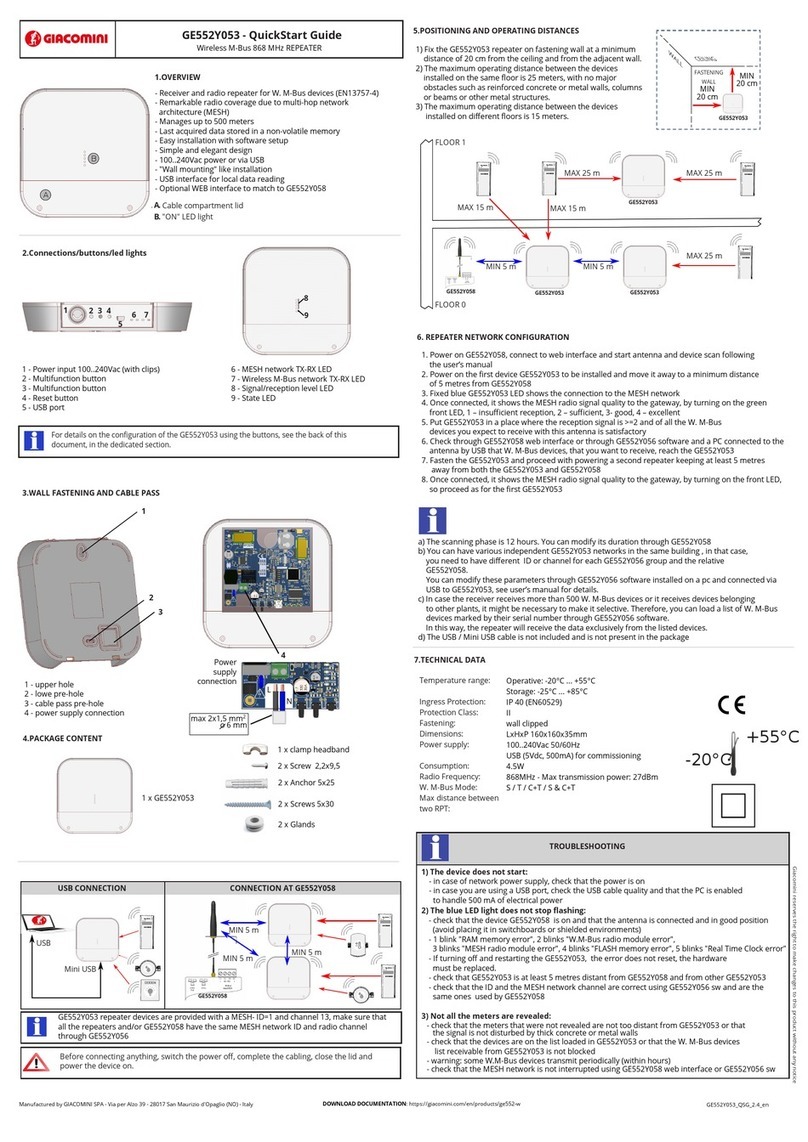
Giacomini
Giacomini GE552Y053 quick start guide
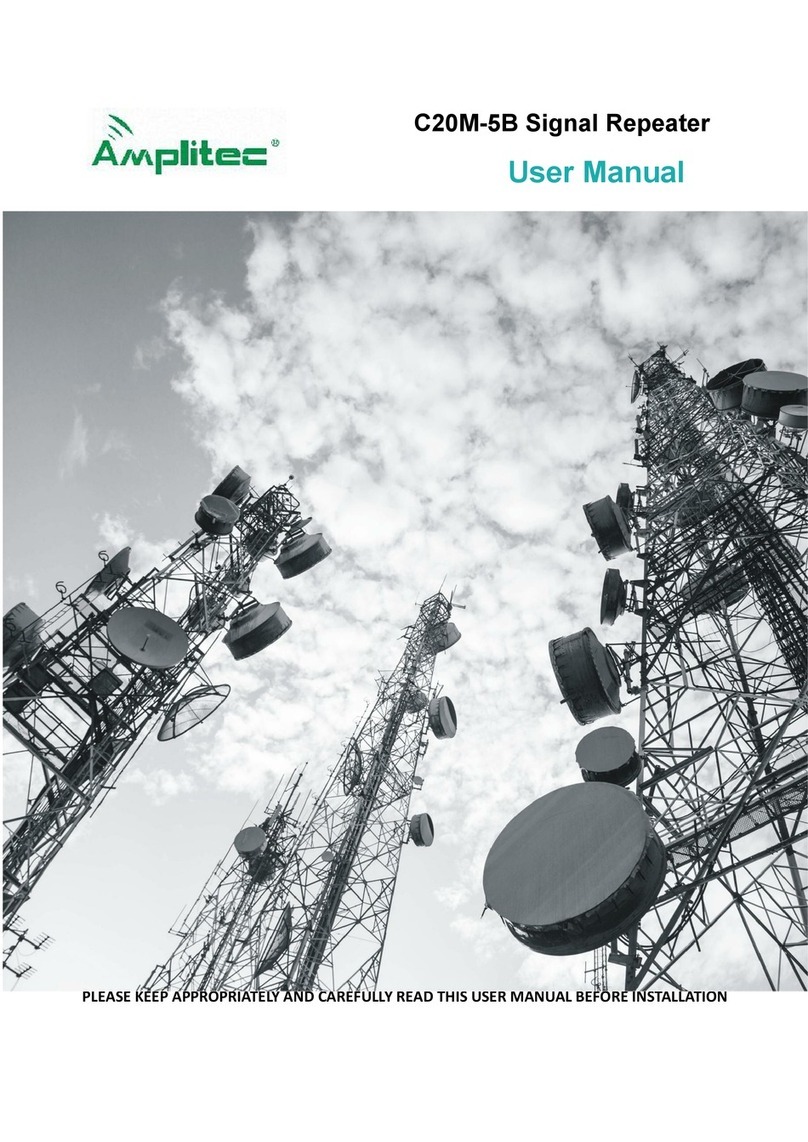
Amplitec
Amplitec C20M-5B Series user manual
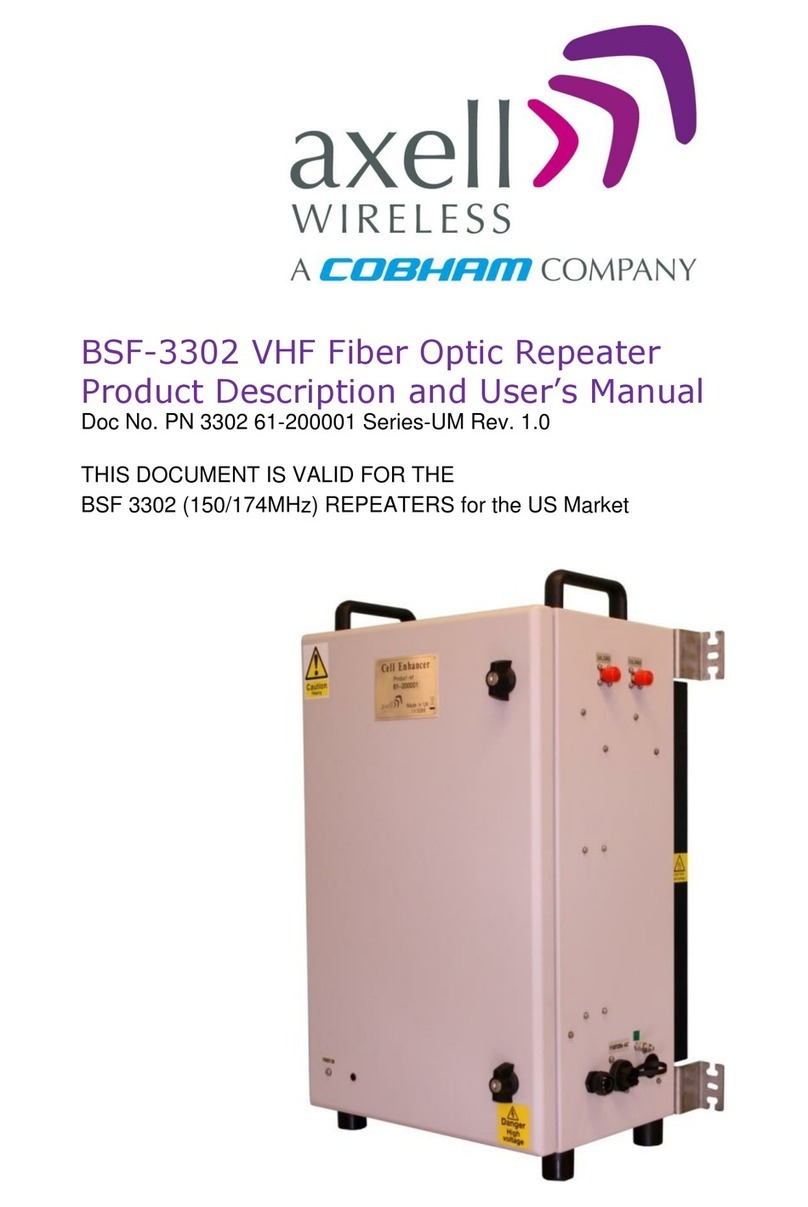
AXELL
AXELL BSF-3302 Product description and user's manual
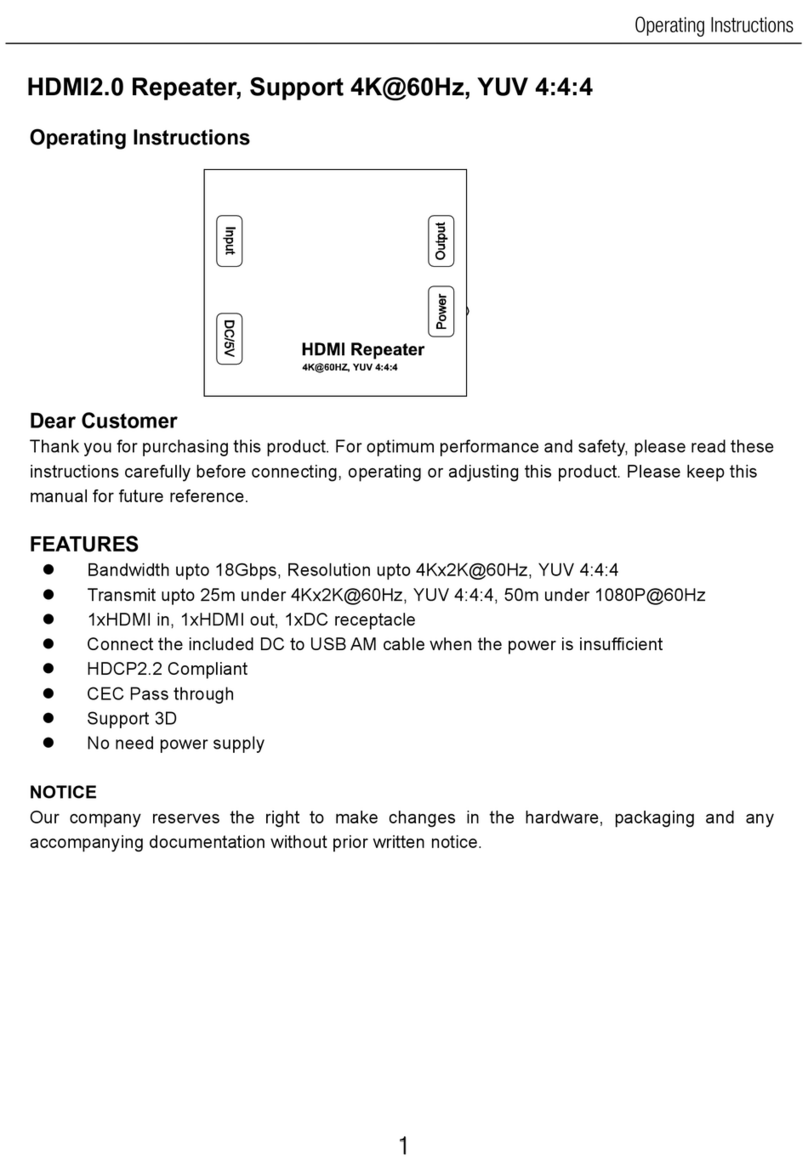
Foxun
Foxun SX-EX39 operating instructions
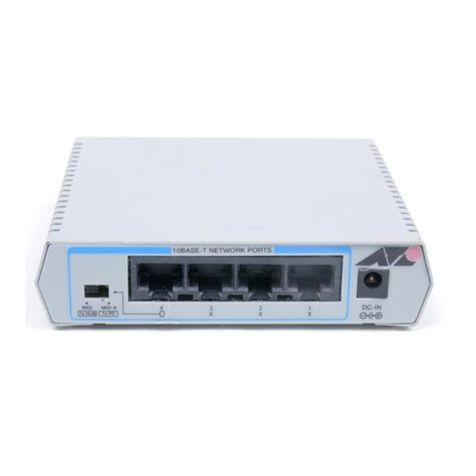
Allied Telesis
Allied Telesis CentreCOM AT-MR415T installation guide
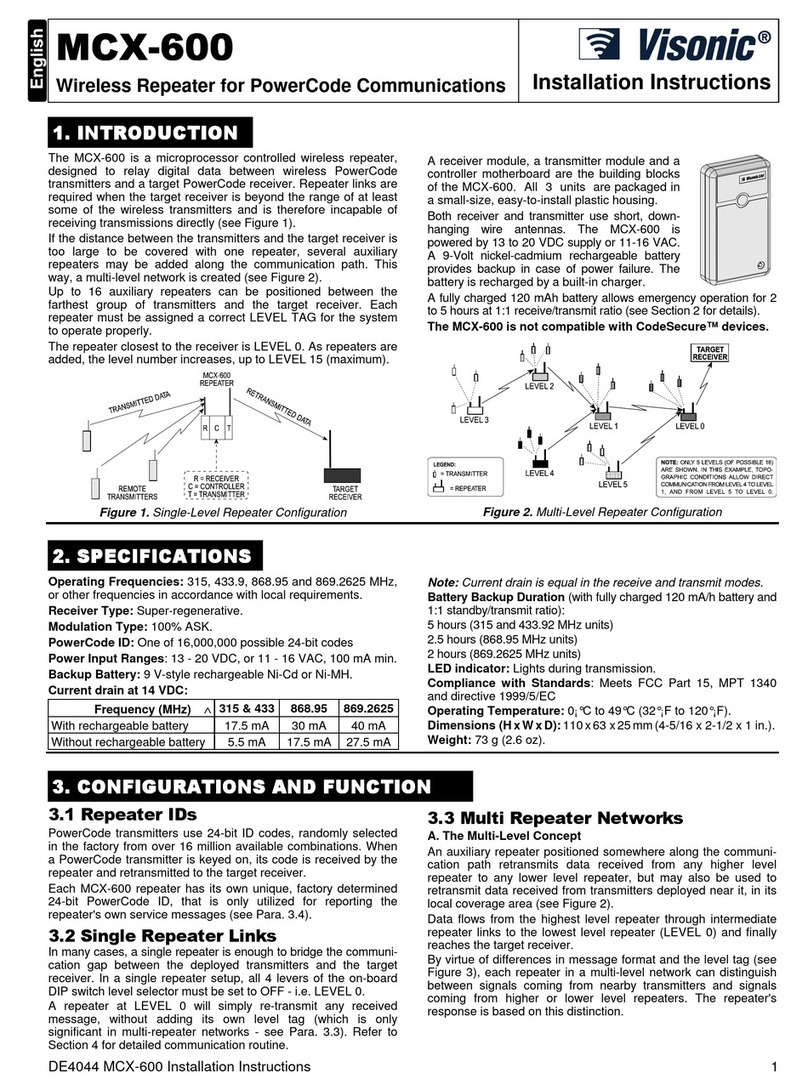
Visonic
Visonic MCX-600 installation instructions
